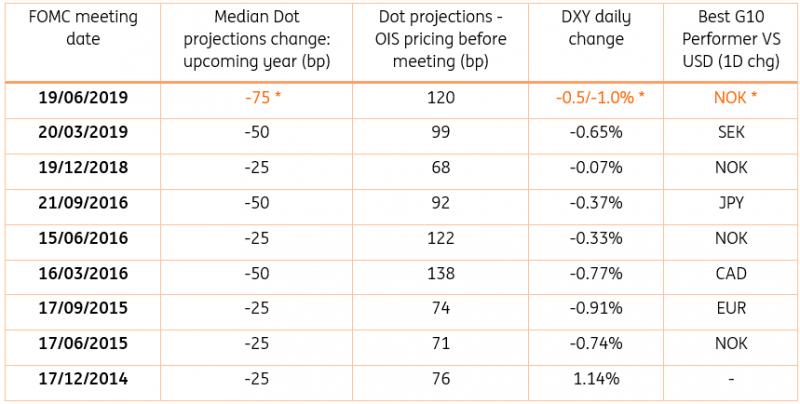Cuts in the dot projections have historically triggered USD weakness. The impact on the dollar will be determined by how closely FOMC members match the market’s dovish pricing.
Dot projections in the spotlight
As the FOMC meets tomorrow, investors are bracing for a dovish shift in the monetary stance, as highlighted by our economists in “Fed to signal cuts are coming”.
The policy rate is widely expected to be kept on hold for now, so the focus will be on forward-looking indicators such as the dot projections. Every three months, FOMC members are asked to anonymously submit their forecasts about where the rates will be at the end of the following three years. The median value of the projections is highly regarded by market participants as a tool to assess the timing and magnitude of the Fed’s monetary policy changes.
Given the aggressive market pricing for rate cuts in the last few months, dot projections will likely be the key variable in the markets’ reaction function.
Historical evidence hints at USD weakness
Currently, the Fed's dot plot is forecasting one rate hike by the end of 2020, far from the nearly four cuts priced in the OIS curve. Starting from 2012, we analysed all the occasions where dot projections for the following year have been cut by the FOMC. The table below shows how the members reduced their policy expectations in relation to what the market was pricing before the meeting, along with the reaction in the FX market.
With the exception of the 2014 December meeting, the dollar index staged losses on the day of the meeting every time the FOMC cut the dot plot. In the G10 space, risk-sensitive currencies came up as the outperformers, with NOK leading the pack on three occasions.
Three scenarios for the dot plot and the USD
Before the most recent dot update in March 2019, the spread between the dot projections and the OIS pricing for end-2020 was almost 100 bp. The Fed covered approximately half of the gap by updating the dots and the DXY sold off (-0.65% in the day). We suspect that during tomorrow’s meeting the FOMC could readjust its dot plot by 75bp to the downside, changing their expectations for one rate hike to two cuts. This would likely be accompanied by a language indicating that the Fed is “closely monitoring the risk” and would pave the way for “insurance” rate cuts in the event of a fierce economic backlash from escalating trade tensions.
This would be the strongest downward revision since 2012 and would cover most of the current 120 bp of difference with the OIS pricing. The 1 year- 2 year segment of the curve would likely stay pressured and the DXY index could drop by 0.5-1.0% on the day. We have also included two other scenarios, each of which hints at different adjustments towards the end of 2020 dots and a different outcome for the USD.
If we are right with our call for the Fed 2020 dots to be cut 75bp, we think USD/NOK might lead the dollar lower (at least for the short term) in what should be a pre-emptive and reflationary move from the Fed. Even though a 25bp Norges Bank hike to 1.25% is priced in for this Thursday, we think tighter Norges Bank policy can keep the NOK supported and a dovish Fed could trigger a USD/NOK reversal to the 8.65 area into Thursday.
Our economists believe the adjustment in the dots may signal that FOMC members expect two of the four cuts priced by the market for end of 2020. All things considered, we expect USD to be under pressure across the board tomorrow, with NOK possibly standing out as the key outperformer.
Read the original analysis: How much does the dot plot matter for the USD?
Content disclaimer: This publication has been prepared by ING solely for information purposes irrespective of a particular user's means, financial situation or investment objectives. The information does not constitute investment recommendation, and nor is it investment, legal or tax advice or an offer or solicitation to purchase or sell any financial instrument. Read more here: https://think.ing.com/content-disclaimer/
Recommended Content
Editors’ Picks
EUR/USD edges lower toward 1.0700 post-US PCE

EUR/USD stays under modest bearish pressure but manages to hold above 1.0700 in the American session on Friday. The US Dollar (USD) gathers strength against its rivals after the stronger-than-forecast PCE inflation data, not allowing the pair to gain traction.
GBP/USD retreats to 1.2500 on renewed USD strength

GBP/USD lost its traction and turned negative on the day near 1.2500. Following the stronger-than-expected PCE inflation readings from the US, the USD stays resilient and makes it difficult for the pair to gather recovery momentum.
Gold struggles to hold above $2,350 following US inflation

Gold turned south and declined toward $2,340, erasing a large portion of its daily gains, as the USD benefited from PCE inflation data. The benchmark 10-year US yield, however, stays in negative territory and helps XAU/USD limit its losses.
Bitcoin Weekly Forecast: BTC’s next breakout could propel it to $80,000 Premium

Bitcoin’s recent price consolidation could be nearing its end as technical indicators and on-chain metrics suggest a potential upward breakout. However, this move would not be straightforward and could punish impatient investors.
Week ahead – Hawkish risk as Fed and NFP on tap, Eurozone data eyed too

Fed meets on Wednesday as US inflation stays elevated. Will Friday’s jobs report bring relief or more angst for the markets? Eurozone flash GDP and CPI numbers in focus for the Euro.

